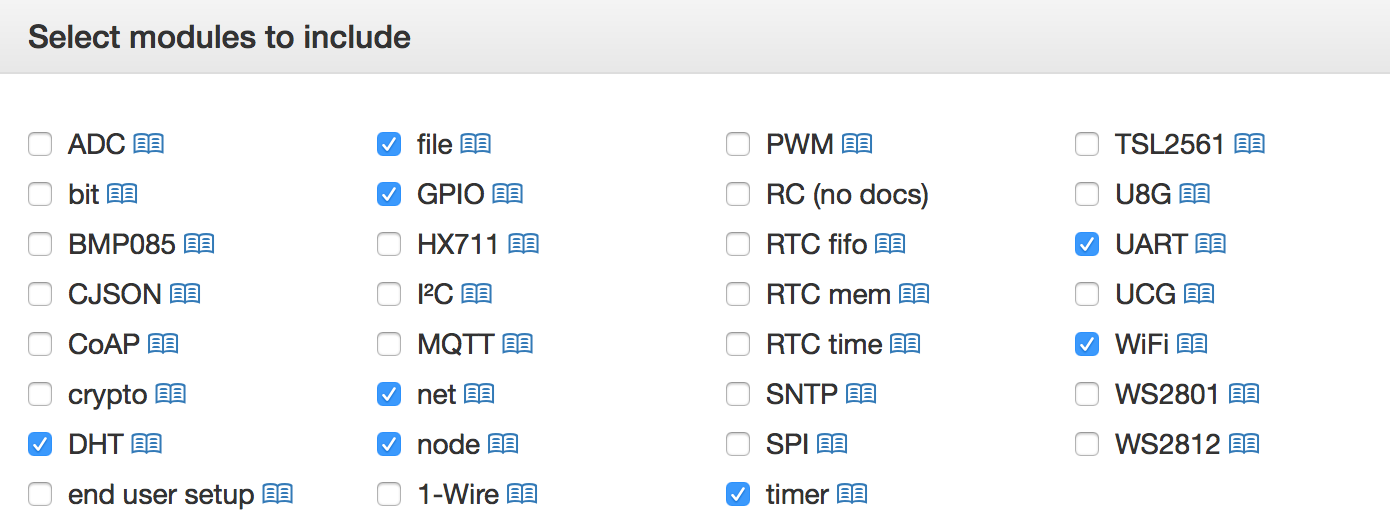ESP8266 NodeMCU - DHT22 sensor and ThingSpeak

I have previously written about pushing temperature and humidity readings from an ESP8266 to a MQTT server using a DHT22 sensor. Later I leveraged NodeMCU’s built-in DHT22 library by using an online service to create a streamlined NodeMCU firmware fit for my needs. However, a reader asked me about pushing data to ThingSpeak.com instead and here is the reply.
Hardware
Follow my post here on how to connect all the parts.
NodeMCU firmware
Follow my post here on how to built a custom NodeMCU firmware and remember to check the DHT library. If you need help flashing the firmware you can take a look at my guide here.

Software
Instead of the test code described in my post here, use the one below. Configure the following variables before uploading to the ESP8266:
thingspeak_channel_api_write_keythingspeak_temperature_field_namethingspeak_humidity_field_namewifi_SSIDwifi_password
And I recommend to use a static IP address for faster connection times, just set the client_* variables.
1
2
3
4
5
6
7
8
9
10
11
12
13
14
15
16
17
18
19
20
21
22
23
24
25
26
27
28
29
30
31
32
33
34
35
36
37
38
39
40
41
42
43
44
45
46
47
48
49
50
51
52
53
54
55
56
57
58
59
60
61
62
63
64
65
66
67
68
69
70
71
72
73
74
75
76
77
78
79
80
81
82
83
84
85
86
87
88
89
90
91
92
93
94
95
96
97
98
99
100
101
102
103
104
105
106
107
108
109
110
111
112
113
114
115
116
117
118
119
120
121
122
123
124
125
126
-- Thingspeak connect script with deep sleep
-- Remember to connect GPIO16 and RST to enable deep sleep
-- TODO: Log error codes to server
--############
--# Settings #
--############
--- Thingspeak ---
thingspeak_channel_api_write_key = "LU1TXYV15GBVTDHU"
thingspeak_temperature_field_name = "field1"
thingspeak_humidity_field_name = "field2"
--- WIFI ---
wifi_SSID = "wifi-Name"
wifi_password = "wifi-Password"
-- wifi.PHYMODE_B 802.11b, More range, Low Transfer rate, More current draw
-- wifi.PHYMODE_G 802.11g, Medium range, Medium transfer rate, Medium current draw
-- wifi.PHYMODE_N 802.11n, Least range, Fast transfer rate, Least current draw
wifi_signal_mode = wifi.PHYMODE_N
-- If the settings below are filled out then the module connects
-- using a static ip address which is faster than DHCP and
-- better for battery life. Blank "" will use DHCP.
-- My own tests show around 1-2 seconds with static ip
-- and 4+ seconds for DHCP
client_ip=""
client_netmask=""
client_gateway=""
--- INTERVAL ---
-- In milliseconds. Remember that the sensor reading,
-- reboot and wifi reconnect takes a few seconds
time_between_sensor_readings = 60000
--################
--# END settings #
--################
temperature = 0
humidity = 0
-- Connect to the wifi network
wifi.setmode(wifi.STATION)
wifi.setphymode(wifi_signal_mode)
wifi.sta.config(wifi_SSID, wifi_password)
wifi.sta.connect()
if client_ip ~= "" then
wifi.sta.setip({ip=client_ip,netmask=client_netmask,gateway=client_gateway})
end
-- DHT22 sensor logic
function get_sensor_Data()
dht=require("dht")
status,temp,humi,temp_decimial,humi_decimial = dht.read(2)
if( status == dht.OK ) then
-- Prevent "0.-2 deg C" or "-2.-6"
temperature = temp.."."..(math.abs(temp_decimial)/100)
humidity = humi.."."..(math.abs(humi_decimial)/100)
-- If temp is zero and temp_decimal is negative, then add "-" to the temperature string
if(temp == 0 and temp_decimial<0) then
temperature = "-"..temperature
end
print("Temperature: "..temperature.." deg C")
print("Humidity: "..humidity.."%")
elseif( status == dht.ERROR_CHECKSUM ) then
print( "DHT Checksum error" )
temperature=-1 --TEST
elseif( status == dht.ERROR_TIMEOUT ) then
print( "DHT Time out" )
temperature=-2 --TEST
end
-- Release module
dht=nil
package.loaded["dht"]=nil
end
function loop()
if wifi.sta.status() == 5 then
-- Stop the loop
tmr.stop(0)
con = nil
con = net.createConnection(net.TCP, 0)
con:on("receive", function(con, payloadout)
if (string.find(payloadout, "Status: 200 OK") ~= nil) then
print("Posted OK to ThingSpeak");
end
end)
con:on("connection", function(con, payloadout)
-- Get sensor data
get_sensor_Data()
-- Post data to Thingspeak
con:send(
"POST /update?api_key=" .. thingspeak_channel_api_write_key ..
"&field1=" .. temperature ..
"&field2=" .. humidity ..
" HTTP/1.1\r\n" ..
"Host: api.thingspeak.com\r\n" ..
"Connection: close\r\n" ..
"Accept: */*\r\n" ..
"User-Agent: Mozilla/4.0 (compatible; esp8266 Lua; Windows NT 5.1)\r\n" ..
"\r\n")
end)
con:on("disconnection", function(con, payloadout)
con:close();
collectgarbage();
print("Going to deep sleep for "..(time_between_sensor_readings/1000).." seconds")
node.dsleep(time_between_sensor_readings*1000)
end)
-- Connect to Thingspeak
con:connect(80,'api.thingspeak.com')
else
print("Connecting...")
end
end
tmr.alarm(0, 100, 1, function() loop() end)
-- Watchdog loop, will force deep sleep the operation somehow takes too long
tmr.alarm(1,4000,1,function() node.dsleep(time_between_sensor_readings*1000) end)
Result
If everything went well you should see the following repeated every 60 seconds on your ESP8266:
NodeMCU custom build by frightanic.com
branch: dev
commit: 093a895980fbd4ab8b3ebedcd6efe36e26419887
SSL: true
modules: node,file,gpio,wifi,net,tmr,adc,dht
built on: 2015-10-13 18:26
powered by Lua 5.1.4
> Connecting...
Temperature: 23.2 deg C
Humidity: 39.1%
Posted OK to ThingSpeak
Going to deep sleep for 60 secondsThe results should now show up right away at your ThingSpeak channel.

Enjoyed this content?
Help keep it free by sending a donation. You can also subscribe to various site feeds to get notified of new posts, follow me on social media, and more.